
After almost 8 months of development the launch of the new version of the project "Open IPC 2.2", this new version being a significant release, since the support for more processors, In addition to the integration of a web interface, the ability to OTA updates for some models among other things.
For those who are not familiar with OpenIPC, you should know that this is a project that develops a Linux distribution for installation on CCTV cameras instead of standard firmware.
The proposed firmware provides features such as support for motion detectors hardware, protocol usage RTSP to distribute video from one camera to more than 10 clients simultaneously, hardware acceleration h264/h265 codecs, support for audio with a sample rate of up to 96KHz, the ability to transcode JPEG images on the fly for interlaced loading, and support for the Adobe DNG RAW format, which solves computational photography problems.
Two levels of support are currently offered to OpenIPC users.
- The first of these is free support through the community (via chat ).
- The second is paid commercial support (here those interested should contact the developer team).
As for those who are interested in being able to know the list of compatible models, you can check the information this link.
It is worth mentioning that unfortunately, not all the mentioned devices are compatible with the firmware. And this is because camera manufacturers tend to change hardware design and swap components even within the same model line, without warning.
That is why even if a model appears supported, the developers recommend that first to determine if the camera is compatible with the latest version of the firmware, it is to open the camera case and observe the chip marks and then look for the chip in the list of compatible hardware and verify its development status.
Main novelties of OpenIPC 2.2
In this new version of the distribution that is presented, as we mentioned at the beginning, this release arrives as main novelty support for more processors, in addition to the already supported HiSilicon, SigmaStar and XiongMai, since those that added to the support list are chips from Novatek and Goke (The latter acquired HiSilicon's IPC business in response to US sanctions against Huawei.)
Another of the changes that stand out from the new version, is for the cameras of some manufacturers, it was possible to install OpenIPC firmware by OTA, with which there is no longer a need to disassemble them and connect them to a UART adapter (the original firmware update system is used).
the project now has a web interface written entirely in shell (a lot of Haserl and Ash).
Opus is now used as the base audio codec, but dynamically switches to AAC based on client capabilities.
On the other hand, it also stands out the embedded player, written in WebAssembly which supports video playback in the H.265 codec and works in modern browsers with support for SIMD instructions about twice as fast as the previous version.
It is also noted that the support for low latency video streaming, which allowed to obtain the latency values of approximately 80 ms in tests of Glass-To-Glass in inexpensive cameras.
And that now there is also the possibility of a non-standard use of cameras as notification systems or IP radio.
Get OpenIPC
For those who are interested in the firmware, you should know that firmware images for IP cameras based on Hisilicon Hi35xx, SigmaStar SSC335/SSC337, XiongmaiTech XM510/XM530/XM550, Goke GK7205 chips were prepared in this new version.
The oldest supported chip is the 3516CV100, which was discontinued by the manufacturer in 2015.
You can consult the installation instructions for some of the compatible models from the following link